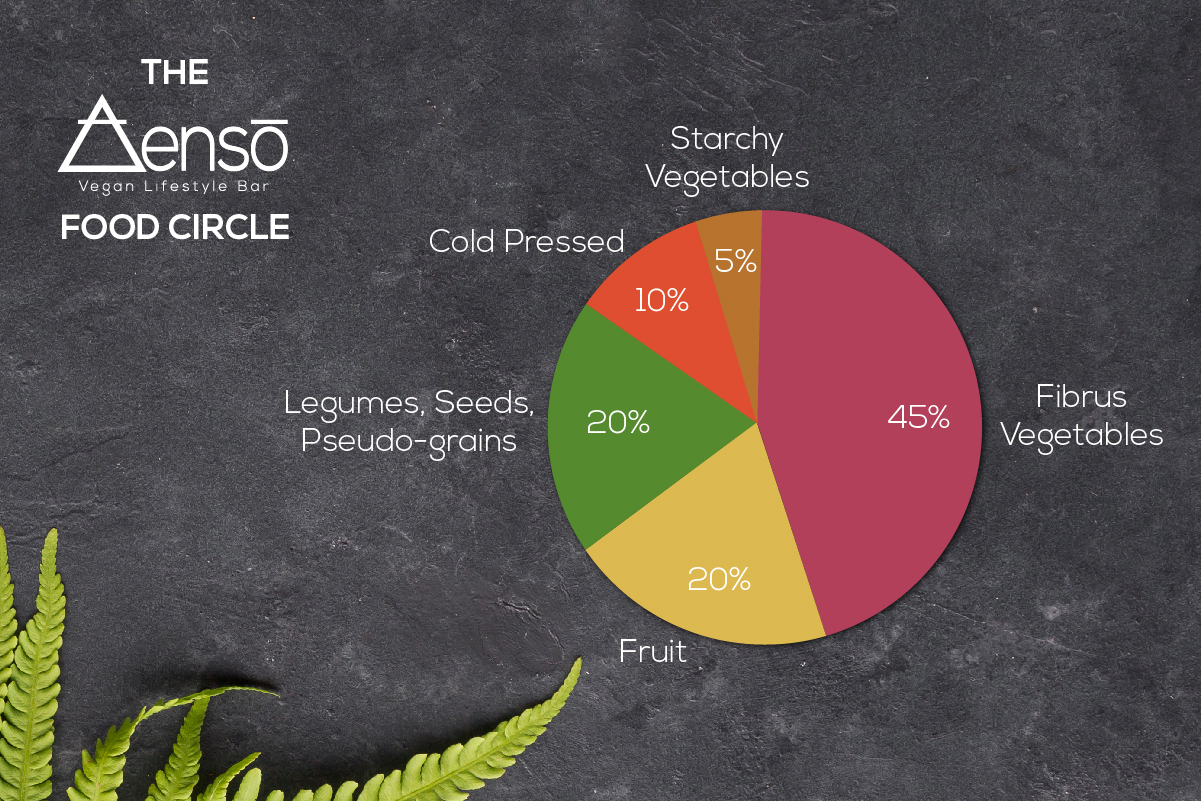
The Vegan Blog
A Simple Introduction to Enso Plant-based Eating
Enso Vegan Lifestyle Bar was created so we can share with you the benefits of clean plant-based eating. And through it, to transform your health and performance. We want to teach you how to harness the power of whole plant-based foods (vegan) as a means to a full, energetic, productive and enjoyable life, regardless of your personal goals.
Top 10 Benefits of a Plant-Based nutritional plan.
There is power in consuming a whole, plant-based, gluten-free diet. Even a small change, like adding some clean, quality super foods to your daily schedule, can help you achieve real benefits.
Make such changes and you can:
- Decrease body fat
- Diminish visible signs of aging
- Boost energy without caffeine or sugar
- Cultivate mental clarity
- Enhance mood
- Eliminate junk-food cravings
- Improve sleep quality
- Build a stronger immune system
- Lower cholesterol
- Reduce biological age
The Enso Food Circle

The Enso Vegan Lifestyle Bar Staple Foods.
The Enso food circle show a suggested ratio of each food group in your daily diet. This is not meant to suggest a hierarchy of nutritional value (that foods higher on the pyramid are worth less than those on the bottom). Combined in balance, these foods will provide premium nutrition, with each group instrumental to your whole nutrition picture.
Carbohydrates from Fiber Fibrous Vegetables
At 45% of the Enso circle you will find fiber-rich carbohydrates emphasizing leafy greens and colorful vegetables that are the foundation of clean, plant-based nutrition. Foods in this section provides a wealth of vitamins, minerals, and phytonutrients.
- Asparagus
- Bok Choy
- Carrots
- Celery
- Cucumbers
- Daikon
- Green beans
- Green peas
- Onions
- Snap peas
- Watercress
- Zucchini
- Squash
- Tomatoes
Dark Leafy Greens.
Dark leafy greens are loaded with fiber and it’s your best choice when it comes to supporting longevity. Rich in necessary vitamins and minerals like vitamin K, iron, electrolytes, and chlorophyll, dark leafy greens also serve as a catalyst to support cleansing in your body.
- Beet greens
- Mustard greens
- Spinach
- Chard
- Dandelion leaves
- Kale
Sea Vegetable. Highly nutrient-dense are one of the highest sources of calcium. Due to high calcium content and other essential minerals, sea vegetables are also quite alkaline-forming. High electrolyte content, great for keeping cells properly hydrated and facilitating proper muscle and nerve impulses function. Sea vegetables often have respectable protein content, too.
- Dulse
- Kelp
- Nori
- Sea asparagus
- Wakame
Carbohydrates from Fruits. Fruits are a great source of carbohydrate energy. Fruits are quickly digested, providing immediate energy, but without the crash associated with refined sugars. Also rich in vitamins and minerals, antioxidants, phytonutrients, and sometimes fiber, fruits are a delicious source of plant-based fuel.
- Apples
- Apricots
- Bananas
- Berries
- Cherries
- Dates
- Figs
- Grapefruit
- Grapes
- Mangos
- Melons
- Nectarines
- Oranges
- Peaches
- Pears
- Pineapple
- Plums
- Pomegranates
Carbohydrates from Starch.
Here at the smallest part the Enso circle, you will find whole, unmodified grains and starchy vegetables that are only required in small amounts.
Starchy Vegetables are a perfect side to a balanced plant-based meal, starchy vegetables are excellent for carb-loading prior to training or an event you have been training for. Due to fiber content some starchy vegetables (yams, pumpkin, and squash) are slower to digest than others, preventing a spike and crash in energy.
- Parsnip
- Pumpkin
- Squash
- Sweet potatoes
- Turnips
- Yams
Grains
Gluten-free grains are much easier to digest –and efficient digestion is a great support for healthy longevity and efficient energy. If you’re not sensitive to gluten, sprouted whole grains breads are also a good alternative to conventional bread.
- Brown rice is Rich in magnesium (needed electrolyte) and selenium (a super antioxidant). You can add a teaspoon of rooibos leaves to cooking water to increase flavor and nutrition profile).
- Spelt is an ancient grain that has not been altered since cultivation began, spelt has 30% more protein than standard whole wheat. Rich in vitamins and minerals, spelt also has significantly less gluten than whole wheat, making it easier to digest, though not gluten-free.
- Teff, is Not only a delicious grain but also rich in minerals including boron, phosphorus, magnesium, copper, zinc, and iron (almost twice as much iron as whole wheat).
- Millet is probably one of the most easily digested grains. Nutrient dense, and high in B vitamins, magnesium, and essential amino acids.
Proteins
Legumes are high in protein, fiber, carbs, vitamins and minerals. Legumes have a prized nutritional profile when it comes to a plant-based diet. Prepare by soaking prior to cooking to ease the digestive process, and increase absorption of essential nutrients.
Beans
- Adzuki
- Black
- Chickpeas
- Fava
- Kidney
- Navy
- Pinto Lentils
- Brown
- Green
- Red Peas
- Black-eyed
- Green (split)
- Yellow (split)
Seeds
Rich in Omega fatty acids essential for your body to function optimally, seeds are a good source of protein and minerals. Plenty of Omega-3 and healthy Omega-6s in the diet is essential for hormone balance, limiting inflammation, supporting brain function, and healthy body composition.
- Flaxseed Excellent source of Omega-3 and insoluble/soluble fiber
- Hempseed High in Omega-3 and protein
- Pumpkin seeds High in zinc
- Sesame seeds High in calcium
- Sunflower seeds Good source of healthy Omega-6
Pseudo-grains (foods that resemble grains from the perspective of a person eating them, but are not biologically members of the same group). Pseudo-grains are actually seeds commonly confused with grains.
These seeds are gluten-free and less starchy, which improves digestibility. Pseudo grains are generally excellent sources of protein, though not every pseudo grain has a complete amino acid profile.
- Amaranth
- Buckwheat
- Wild rice
- Quinoa (complete protein)
Fats / Oils
Whole food-derived oils that are minimally-processed provide essential healthy fats like Omega-3 and Omega-6. However, all oils are not created equal; look for cold-pressed oils that have not been chemically altered.
- Hemp oil (Omega-3 and chlorophyll rich)
- Flaxseed oil (Omega-3 rich)
- Extra-virgin olive oil (rich in healthy Omega-6, but with minimal Omega-3 content)
- Pumpkin seed oil
- Coconut oil (virgin)
Nuts
Delivering a balance of quality protein and healthy fats, nuts are better digested after soaking.
- Brazil nuts
- Cashews
- Almonds
- Hazelnuts
- Pecans
- Pine nuts
- Pistachio
- Walnuts
- Macadamia nuts
Enso’s Top 5 Energy-Boosting Tips
What you eat and how much energy you have are connected.
- Energize through nourishment gives you more sustainable energy—the kind that lasts for hours so you can power through your busiest days and hardest workouts. This kind of energy comes from only one source: clean nutrition. Nutrient dense, plant-based whole foods deliver a balance of quality protein, complex, fiber-rich carbohydrates, healthy fats, and essential micronutrients that energize while providing a platform for long-term wellness and vitality.
- Swap out stimulants. The energy you get from caffeine and refined sugar isn’t only fleeting and usually followed by a crash, but it also creates an unsustainable biological debt—the fatigue that sets in when stimulant energy wears off—that leaves you craving more stimulation just to feel right again. If you can’t start your day without a second cup of coffee, it may be time to dial back the caffeine. Start by substituting coffee for green tea, and gradually work your way to caffeine-free pick-me-ups that also help bust stress.
- Choose complex carbs as the base of your diet. Simply put, carbs are energy. In spite of what fad diets say, you shouldn’t try avoiding carbs altogether—your body will burn muscle tissue for fuel without them. Instead, identify the best carbohydrate choices to energize and help you perform at your best. The best carbohydrates are the complex, whole food kind, found in fiber-rich vegetables, like kale, carrots, and spinach. Providing sustained and long-lasting energy, slow-burning complex carbs are low on the glycemic index, helping to stabilize blood sugar.
- Replace refined sugars with low glycemic options, if you want to go through your day in a smooth way. Help balance blood sugar levels by choosing low glycemic sweeteners over refined, high glycemic sugars. What makes a sweetener (or food) low glycemic? We will talk about the glycemic index in another post, But in the meantime, here’s a quick summary:
- Measuring how fast the carbs in food are broken down into glucose, and how long it takes for glucose to affect your blood sugar levels. The glycemic index is a scale from 0-100
- Foods like white bread or those with added sugars are high GI
- Foods like beans, legumes, and kale are low GI
- Low GI foods (55 GI or lower) provide energy without the blood sugar spike.
Swapping refined sugars for low glycemic sweeteners like agave nectar, maple syrup will give you the sweetness you crave— without the energy crash.
- Hydrate throughout the day so you don’t feel sluggish. Dehydration reduces blood volume, lowering blood pressure and making you feel tired. Hydrate proactively to stay energized. Sip water throughout the day so you don’t feel thirsty, and remember to top up electrolytes in hot weather, and especially before, during, and after physical activity. Flavor your water with lemon, mint, or cucumber or switch it up with coconut water to help keep things interesting.
Juliette Christodoulou | the Chef
Chef, Juliette Christodoulou
Stay on top of the latest flavors
Subscribe to our mailing list below for exclusive updates and
be the first to discover our latest new and flavours.


